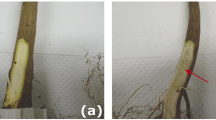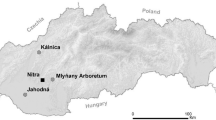Abstract
The pathogenic fungi Verticillium alboatrum and Diplodia scrobiculata were assayed for biological control of Diplodia pinea on Aleppo pine (Pinus halepensis) in Catalonia (north-eastern Spain). Young shoots were pre-treated with inoculations of either V. dahliae or D. scrobiculata, by placing colonized agar plugs on wounds made by removing a single needle fascicle. An inoculation with D. pinea was performed 15 days later. Two months after the shoot inoculations, the canker length on the stems was measured and the percentage of shoot dieback calculated. Verticillium dahliae and D. scrobiculata were found to significantly reduce the canker length of D. pinea (P < 0.05) when compared with positive controls. Diplodia pinea was slightly more sensitive to V. dahliae than to D. scrobiculata, but no significant differences (P > 0.05) were observed in the mean canker length between the two treatments. Trees pre-inoculated with V. dahliae resulted in 31.12% shoot dieback, while those pre-inoculated with D. scrobiculata resulted in 32.18% shoot dieback, compared with positive controls (42.85%).



Similar content being viewed by others
References
Blodgett, J. T., & Bonello, P. (2003). The aggressiveness of Sphaeropsis sapinea on Austrian pine varies with isolate group and site of infection. Forest Pathology, 33, 15–19.
Blodgett, J. T., & Stanosz, G. R. (1999). Differences in aggressiveness of Sphaeropsis sapinea RAPD marker group isolates on several conifers. Plant Disease, 83, 853–856.
Blodgett, J. T., Bellizzi, M., & Bonello, P. (2003). The induction of systemic resistance and systemic susceptibility in Sphaeropsis sapinea inoculated Pinus nigra. In J. Stone, H. Maffei (Eds.). 50th Western Int Forest Disease Working Conference (pp. 46–47). USDA Forest Service, Powell River, British Columbia, Canada.
Blodgett, J. T., Eyles, A., & Bonello, P. (2007). Organ-dependent induction of systemic resistance and systemic susceptibility in Pinus nigra inoculated with Sphaeropsis sapinea and Diplodia scrobiculata. Tree Physiology, 27, 511–517.
Bonello, P., & Blodgett, J. T. (2004). Pinus nigra–Sphaeropsis sapinea as a model pathosystem to investigate local and systemic effects of fungal infection of pines. Physiological and Molecular Plant Pathology, 63, 249–261.
Bonello, P., Gordon, T. R., & Storer, A. J. (2001). Systemic induced resistance in Monterey pine. Forest Pathology, 31, 99–106.
Burgess, T., & Wingfield, M. J. (2001). Simple sequence repeat markers distinguish among morphotypes of Sphaeropsis sapinea. Applied and Environmental Microbiology, 67, 354–362.
Campbell, M. M., & Ellis, B. E. (1992). Fungal elicitor-mediated responses in pine cell cultures: Cell wall-bound phenolics. Phytochemistry, 31, 737–742.
Christiansen, E., Krokene, P., Berryman, A. A., Franceschi, V. R., Krekling, T., Lieutieur, F., et al. (1999). Mechanical injury and fungal infection induce acquired resistance in Norway spruce. Tree Physiology, 19, 601–615.
de Wet, J., Burgers, T., Slippers, B., Preising, O., Wingfield, B. D., & Wingfield, M. J. (2003). Multiple gene genealogies and microsatellite markers reflect relationships between morphotypes of Sphaeropsis sapinea and distinguish a new species of Diplodia. Mycological Research, 107, 557–566.
de Wet, J., Burgers, T., Slippers, B., Preising, O., Wingfield, B. D., Wingfield, M. J., et al. (2000). Characterization of Sphaeropsis sapinea isolates from South Africa, Mexico and Indonesia. Plant Disease, 84, 151–156
Durrant, W. E., & Dong, X. (2004). Systemic acquired resistance. Annual Review of Phytopathology, 42, 185–209.
Engelbrecht, C., & Gleason, M. (2006). Verticillium wilt of woody plants. Sustainable urban landscapes. Iowa: State University.
Flowers, J., Hartman, J., & Vaillancourt, L. (2003). Detection of latent Sphaeropsis sapinea infections in Austrian pine tissues using nested-polymerase chain reaction. Phytopathology, 83, 1471–1477.
Franceschi, V. R., Krokene, P., Krekling, T., & Christiansen, E. (2000). Phloem parenchyma cells are involved in local and distant defense responses to fungal inoculation on bark-beetle attack in Norway spruce (Pinaceae). American Journal of Botany, 87, 314–326.
Gordon, T. R., Wikler, W. K., Clark, S. L., Okamoto, D., Storer, A. J., & Bonello, P. (1998). Resistance to pitch canker disease, caused by Fusarium subglutinans f. sp. pini in Monterey pine (Pinus radiata). Plant Pathology, 47, 706–711.
Helton, A. W., & Brown, J. W. (1971). Induced resistance to Cytospora in bearing trees of Prunus domestica. Phytopathology, 61, 721–723.
Jacobs, K. A., & Guries, R. P. (2003) Evaluating the effectiveness of the dutch trig® strain of Verticillium dahliae in cloned ramets of american hybrids. Elm conference abstracts (pp 45). Valsaín, Segovia, Spain.
Krokene, P., Chistiansen, E., Solheim, H., Franceschi, V. R., & Berryman, A. A. (1999). Induced resistance to pathogenic fungi in Norway spruce. Plant Physiology, 121, 565–569.
Krokene, P., Solheim, H., & Långström, B. (2000). Fungal infection and mechanical wounding induce disease resistance in Scots pine. European Journal of Plant Pathology, 106, 537–541.
Luchi, N., Ma, R., Capretti, P., & Bonello, P. (2005). Systemic induction of traumatic resin ducts and resin flow in Austrian pine by wounding and inoculation with Sphaeropsis sapinea and Diplodia scrobiculata. Planta, 221, 75–84.
Moret, A., & Muñoz, Z. (2007). Control of Diplodia pinea and D. scrobiculata in Pinus halepensis by 5-chloro-salicylic acid. Phytopathogia Mediterranea. (in press)
Moret, A., Nadal, M., García, F., & Montón, C. (1995). Caracterización de aislados de Sphaeropsis sapinea (Fr.) Dyko et Sutton mediante cromatografía de gases. Boletín Sanidad Vegetal Plagas, 21, 371–376.
Nadal, M., Moret, A., & Ferrer, R. (2005). Léxico de las enfermedades producidas por hongos. Phytoma. España.
Palmer, M. A., & Nichols, T. H. (1985). Shoot blight and collar rot of Pinus resinosa caused by Sphaeropsis sapinea in forest tree nurseries. Plant Disease, 69, 739–740.
Palmer, M. A., Stewart, E. L., & Wingfield, M. J. (1987). Variation among isolates of Sphaeropsis sapinea in North Central United States. Phytopathology, 77, 944–948.
Reglinski, T., Hotter, G., Taylor, J. T., & Stavely, F. J. L. (1998). Elicitation of defence responses in Pinus radiata seedlings and suspensions cells, and induction of resistance to Sphaeropsis sapinea. In: Abstracts, Seventh International Congress of Plant Pathology. August 9–19. Edinburgh, Scotland.
Ryals, J., Neuenschwander, U., Willis, M., Molina, A., Steiner, H. Y., & Hunt, M. (1996). Systemic acquired resistance in plants. Plant Cell, 8, 1809–1819.
Scheffer, R. J. (1989). Pseudomonas for biological control of Dutch elm disease: III. Field trials at various locations in the Netherlands. Netherlands Journal Plant Pathology, 95, 305–318.
Schneider, M., Schweizer, P., Meuwly, P., & Métraux, J. P. (1996). Systemic acquired resistance in plants. International Journal of Cytology, 168, 303–340.
Shi, J. L., & Brasier, C. M. (1986). Experiments on the control of Dutch elm disease by injection of Pseudomonas species. European Journal of Forest Pathology, 16, 280–292.
Sinclair, W. A., Lyon, H. H., & Johnson, W. T. (1987). Diseases of Trees and Shrubs. Ithaca, New York: Cornell University Press.
Smith, D. R., & Stanoz, G. R. (2006). A species specific PCR assay for detection of Diplodia pinea and D. scrobiculata in dead red and jack pines with collar rot symptoms. Plant Disease, 90, 307–313.
Sticher, L., Mauch-Mani, B., & Métraux, P. (1997). Systemic acquired resistance. Annual Review of Phytopathology, 35, 235–270.
Storer, A. J., Gordon, T. R., & Wood, D. L. (1999). Evidence of resistance to pitch canker pathogen (F. circinatum) in native stands of Monterrey pine (Pinus radiata). Forest Science, 45, 500–505.
van Loon, L. C. (1997). Induced resistance in plants and the role of pathogenesis related proteins. European Journal of Plant Pathology, 103, 753–765
van Loon, L. C., Rep, M., & Pieterse, C. M. J. (2006). Significance of inducible defense-related proteins in infected plants. Annual Review of Phytopathology, 44, 135–162.
Voeten J (2003) Dutch trig®: a decade of successful biological control of dutch elm disease in Europe and the USA. Elm conference abstracts (pp 35). Valsaín, Segovia, Spain.
Wang, C. J., Blanchette, R. A., & Palmer, M. A. (1986). Ultrastructural aspects of the conidium cell wall of Sphaeropsis sapinea. Mycologia, 78, 960–963.
Wang, D., Eyles, A., Mandich, D., & Bonello, P. (2006). Systemic aspects of host–pathogen interactions in Austrian pine (Pinus nigra): A proteomics approach. Physiological and Molecular Plant Pathology, 68, 149–157.
Zhou, S., Smith, D. R., & Stanosz, G. R. (2001). Differentiation of Botryosphaeria species and related anamorphic fungi using inter simple or short sequence repeat (ISSR) fingerprinting. Mycological Research, 105, 919–926.
Author information
Authors and Affiliations
Corresponding author
Rights and permissions
About this article
Cite this article
Muñoz, Z., Moret, A. & Garcés, S. The use of Verticillium dahliae and Diplodia scrobiculata to induce resistance in Pinus halepensis against Diplodia pinea infection. Eur J Plant Pathol 120, 331–337 (2008). https://doi.org/10.1007/s10658-007-9221-x
Received:
Accepted:
Published:
Issue Date:
DOI: https://doi.org/10.1007/s10658-007-9221-x




